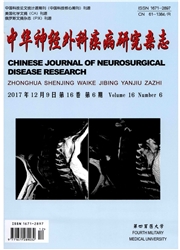

 中文摘要:
中文摘要:
目的分离液压性脑损伤室下区巢蛋白(nestin)和胶质酸性纤维蛋白(GFAP)阳性(nestin^+/GFAP^+)共存细胞进行培养和诱导分化,观察其分裂、增殖和分化能力,以阐明损伤反应性星形胶质细胞增生过程中nestin^+/GFAP^+共存细胞是否具有神经干细胞特性。方法用液压冲击法建立动物模型,分离损伤成年SD大鼠室下区nestin^+/GFAP^+共存细胞,制成单细胞悬液,培养和诱导分化,以免疫荧光化学方法对原代和传代培养形成的神经球以及原代和传代培养诱导分化的细胞进行鉴定。结果结果显示培养及传代的细胞不断分裂增殖,可以形成悬浮生长nestin阳性的神经球;神经球诱导分化后可以分化为少突胶质细胞、神经元和星形胶质细胞。结论成年大鼠液压性脑损伤后分离的室下区细胞具有自我更新能力和多向分化潜能,是中枢神经系统神经干细胞。
 英文摘要:
英文摘要:
Objective The coexisting cells of nestin and glial fibrillary acid protein (GFAP) (nestin ^+/ GFAP^+ ) were cultured and induced to differentiate. By this way, whether the clone-sphere and these cells might be differentiated into astrocytes, oligodendrocytes or neurons were investigated. Methods Animal model was established by moderate lateral fluid percussion. Coexisting cells of nestin^+/GFAP^+ were separated from subventricular zone of SD rats to make single cell suspension. And the cells were cultured and induced to differentiate. Then, primary and subculture neurosphere as well as primary and subculture differentiated cells were measured with immunofluorescence. Results Subcuhurcd cells presented the proliferation and positivenestin neurosphere formed. Differentiated cells were oligedendrocytes, neurons or astrocytes. Conclusion Cells separated from brain subventricular zone have a good ability in differentiation and self-renewing. These cells can differentiate into neurons, oligodendrocytes or astrocytes. They are stem cells of central nervous system (CNS).
 同期刊论文项目
同期刊论文项目
 同项目期刊论文
同项目期刊论文
 期刊信息
期刊信息
